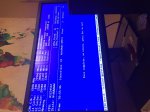wreedps
Patron
- Joined
- Jul 22, 2015
- Messages
- 225
Supermicro X9SRL with Xeon 2670 Running 9.3 Latest build
128GB ECC DDR
8x 900GB 10K SAS with mirrored dev. 128GB Extreme Pro Cache SSD.
2x Dual Port Chelsio 10Gbe directly connected to 2 ESXi 6 hosts.
What are some stress tests I could do to this box to test it out before placing into production?
I have done some simple testing. I can clone a 2008 R2 template in 36sec to 1 min on it. Pretty impressive.
128GB ECC DDR
8x 900GB 10K SAS with mirrored dev. 128GB Extreme Pro Cache SSD.
2x Dual Port Chelsio 10Gbe directly connected to 2 ESXi 6 hosts.
What are some stress tests I could do to this box to test it out before placing into production?
I have done some simple testing. I can clone a 2008 R2 template in 36sec to 1 min on it. Pretty impressive.

